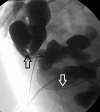Management of transcecal renal transplant nephrostomy
- PMID: 24436522
- PMCID: PMC3700794
- DOI: 10.1055/s-0033-1333658
Management of transcecal renal transplant nephrostomy
Figures









References
-
- Miller G L, Summa J. Transcolonic placement of a percutaneous nephrostomy tube: recognition and treatment. J Vasc Interv Radiol. 1997;8(3):401–403. - PubMed
-
- Saad W EA, Moorthy M, Ginat D. Percutaneous nephrostomy: native and transplanted kidneys. Tech Vasc Interv Radiol. 2009;12(3):172–192. - PubMed
-
- Gerspach J M, Bellman G C, Stoller M L, Fugelso P. Conservative management of colon injury following percutaneous renal surgery. Urology. 1997;49(6):831–836. - PubMed
-
- Zagoria R J, Dyer R B. Do's and don't's of percutaneous nephrostomy. Acad Radiol. 1999;6(6):370–377. - PubMed
Publication types
LinkOut - more resources
Full Text Sources
Other Literature Sources

